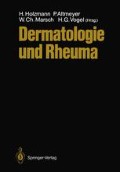Zusammenfassung
Der HHK des Menschen liegt auf dem kurzen Arm des Chromosoms 6 und kontrolliert die Ausprägung der „Human Leukozyten-Antigene“(HLA), verschiedenartige Immunantworten, Komplementkomponenten (C2, C4, BF) und schließlich sogenannte Krankheits-Empfänglichkeits-Gene (Disease Susceptibility = DS-Gene). Die HHK-Genprodukte lassen sich in die Klassen I bis III gliedern: Klasse I umfaßt die Glykoproteine der Zellmembran, die von den Genorten HLA A, B und C gesteuert werden. Diese Merkmale sind auf allen kernhaltigen Zellen und Thrombozyten nachzuweisen. Die Klasse-II-Moleküle sind gleichfalls an der Zelloberfläche nachweisbar, sie steuern die Expression der Genprodukte von HLA DR, DQ und DP. Diese Merkmale sind nur auf einigen Blutzellen, wie z.B. den B-Lymphozyten, Monozyten und Makrophagen nachweisbar. Zu den Klasse-III-Molekülen rechnet der Properdinfaktor B (BF) im alternativen Aktivierungsweg der Komplementkaskade, sowie die Faktoren C2 und C4 (C4A, C4B) der klassischen Komplementaktivierung (Abb. 1). Bei allen drei Molekülklassen ist ein ausgeprägter Polymorphismus nachzuweisen, so daß sich die Zahl der theoretisch möglichen Kombinationen in einer Größenordnung von 20 × 109 bewegt [12] und darin von keinem anderen Blutgruppen-System übertroffen wird. Der HHK codiert mindestens 120 verschiedene HLA-Spezifitäten an sieben Genorten (23 A-, 47 B-, 8 C-, 19 D-, 14 DR-, 3 DQ- und 6 DP-Antigene, ohne die breiten Spezifitäten BW4 und BW6 sowie DRW52 und DRW53).
Access this chapter
Tax calculation will be finalised at checkout
Purchases are for personal use only
Preview
Unable to display preview. Download preview PDF.
Literatur
Boyse EA, Beauchamp GK, Yamazaki K (1983) Critical Review: The sensory perception of genotypic polymorphism of the major histocompatibility complex and other genes: Some physiological and phylogenetic implications. Hum Immunol 6: 177–183
Brewerton DA, Caffrey M, Hart FD, James DCO, Nicholls A, Sturrock RD (1973) Ankylosing spondylitis and HL-A 27. Lancet i: 904–907
Burger R (1986) Genetische Aspekte der Immunabwehr. Die Gelben Hefte 26: 1–10
Darden AG, Streilein JW (1984) Syrian hamsters express two monomorphic class I major histocompatibility complex molecules. Immunogenetics 20: 603–620
Dausset J, Svejgaard A (1977) HLA and Disease. Munksgaard, Copenhagen.
Dienst C, Gross R (1982) Das Reiter-Syndrom. Deutsches Ärzteblatt 7: 29–35
Freudenberg J, Holzmann H, Schneider S, Korting GW (1978) HLA-Antigenfrequenzen bei Patienten mit progressiver Sklerodermie und Morphea. Arch Dermatol Res 263: 197–205
Honda Y, Asaka A, Tanaka Y, Juji T (1983) Discrimination of narcoleptic patients by using genetic markers and HLA. Sleep Research 12: 254
Kühnl P, Schütz K, Altmeyer P, Holzmann H, Seidl S (1985) Assoziation von HLA-Antigenen und Sklerodermie. Z Hautkr 60: 866–868
Leibold W (1984) Humane Leukozytenantigene. In: Thomas L (Hrsg) Med Verlagsges Marburg/ L (Labor und Diagnose, pp 651–663)
Lenhard V (1983) MHC und Krankheiten. In: Immunologie. Vorlaender KO (Hrsg) pp 807–810. Thieme, Stuttgart, New York
Mayr WR (1985) Das HLA-System. I. Teil. MTA-Journal 7: 156–163
Miehle W, Schattenkirchner M, Albert D, Bunge M (1984) Spondylitis ankylosans mit und ohne periphere Gelenkbeteiligung. Fortschr Med 21: 581–585
Mueller-Eckhardt G, Meier-Ewert K, Schendel DJ, Reinecker FB, Multhoff G, Mueller-Eckhardt C (1986) HLA and narcolepsy in a German population. Tissue Antigens 28: 163–169
Rittner C, Kühnl P, Black CM, Pereira S, Welsh KI (1984) Scleroderma: Possible Association with the C4 System — A Progress Report. In: Albert ED, Baur MP, Mayr WR (ed) Springer, Berlin, Heidelberg, New York, Tokyo (Histocompatibility Testing pp 394–397)
Rodey GE (1984) HLA genes and disease susceptibility. Adv Immunobiol 149: 235–253
Rodey GE (1985) In: International Forum; Is it Possible to Formulate a Unified Concept for the Biological Function of the Major Histocompatibility Complex? Vox Sang 49: 354–367
Rother K (1985) Immunologie heute: Stellenwert in der Klinik. Die Gelben Hefte 25:139–151
Ryder LP, Andersen E, Svejgaard A (1979) HLA and Disease Registry. Munksgaard, Copenhagen
Schlosstein L, Terasaki PI, Bluestone R, Pearson CM (1973) High association of an HLA antigen, W27 with ankylosing spondylitis. New Engl J Med 288: 704–706
Sasazuki T, Nishimura T, Muto M (1984) MHC-linked immune suppression genes and their role in immunological disorders. In: Sasuki Tada, Immunogenetics: its application to clinical medicine. Academic Press, New York
Spielmann W, Kühnl P (1982) Leukozyten- und Thrombozytenantigene. In: Blutgruppenkunde, Thieme, Stuttgart, New York pp 215–250
Svejgaard A (1986) The HLA System: Biological Function and Association with Disease. In: Brinkmann B, Henningsen K (ed) p 18. Advances in Forensic Haemogenetics 1, Springer, Berlin, Heidelberg
Svejgaard A, Hauge M, Jersild C, Platz P, Ryder LP, Staub-Nielsen L, Thomsen M (1979) The HLA System. An Introductory Survey, 2nd ed Karger, Basel, München, Paris, London, New York, Sydney
Svejgaard A, Platz P, Ryder LP (1983) HLA and Disease 1982 — A Survey. Immunological Rev 70: 193–218
Tiwari LT, Terasaki PI (1985) HLA and Disease Associations. Springer, New York, Berlin, Heidelberg, Tokyo
Zinkernagel RM, Doherty PC (1974) Restriction of in vitro T-cell-mediated cytotoxicity in lymphocytic choriomeningitis virus within a syngeneic semiallogeneic system. Nature 248: 701–702
Editor information
Editors and Affiliations
Rights and permissions
Copyright information
© 1987 Springer-Verlag Berlin Heidelberg
About this paper
Cite this paper
Kühnl, P., Seidl, S., Holzmann, H. (1987). Immungenetik. In: Holzmann, H., Altmeyer, P., Marsch, W.C., Vogel, H.G. (eds) Dermatologie und Rheuma. Springer, Berlin, Heidelberg. https://doi.org/10.1007/978-3-642-72668-2_8
Download citation
DOI: https://doi.org/10.1007/978-3-642-72668-2_8
Publisher Name: Springer, Berlin, Heidelberg
Print ISBN: 978-3-642-72669-9
Online ISBN: 978-3-642-72668-2
eBook Packages: Springer Book Archive

